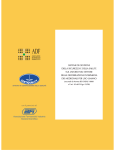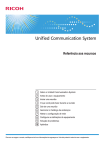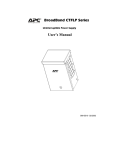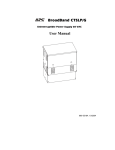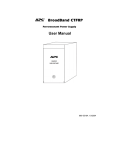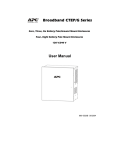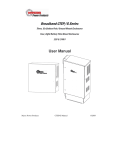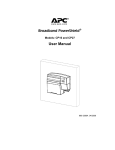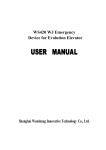Download APC CTSLLP/G Power Supply User Manual
Transcript
BroadBand CTSLLP/G Series Pole and Ground Mount Standby Power Supply Enclosures User Manual 990-5517 04/2003 Chapter 1 General Information The CTSLLP/G Standby Power Supply Series Enclosures provide a power source for broadband cable operations. Safety This Safety Guide contains important instructions that should be followed during installation and maintenance of the APC equipment and batteries. It is intended for APC customers who setup, install, relocate, or maintain APC equipment. Changes and modifications to this unit not expressly approved by APC could void the warranty. Failure to observe these warnings may result in serious injury, death or damage to the equipment. • Do not work alone under hazardous conditions. • Do not handle any metallic connector before the power has been disconnected. • Servicing this equipment may require working with protective covers removed and utility power connected. Use extreme caution during these procedures. • High current through conductive materials could cause severe burns. • When grounding cannot be verified, disconnect the equipment from the utility power outlet before installing or connecting to other equipment. Reconnect the power cord only after all connections are made. • Check that the power cord(s), plug(s), and sockets are in good condition. • Replacement of fuses or other parts must be with identical types and ratings. Substitution of nonidentical parts may cause safety and fire hazards. Lifting Warnings • These units are heavy. Use proper lifting techniques and equipment to avoid injury. Overhead Warnings • Never stand underneath anything while it is being hoisted. • Always wear a hardhat. Electrical Warnings 1 Specifications Environmental Specifications Operating Temperature -40º F to 140º F (-40º C to 60º C) Humidity 5% to 95% noncondensing within enclosure Physical Specifications Characteristic Height x Width x Depth CTSLLGULH110S1 CTSLLPULH100S1 CTSLLGECH220S1 Weight CTSLLGULH110S1 CTSLLPULH100S1 CTSLLGECH220S1 Specification 20” x 22” x 7.5” (51cm x 56 cm x 19 cm) 14” x 22” x 7.5” (36 cm x 56 cm x 19 cm) 20” x 22” x 7.5” (51cm x 56 cm x 19 cm) 20 lbs (9 kg) 16 lbs (7 kg) 20 lbs (9 kg) Electrical Specifications Input Characteristic Input Voltage CTSLLGULH110S1 CTSLLPULH100S1 CTSLLGECH220S1 Input Specification 120 Vac 120 Vac 220 Vac 2 Chapter 2 Installation Only trained service personnel should install and maintain the power supply. Prior to installation, utility line voltage must be routed to the enclosure. Local, state, federal and/or National Electric Code (NEC) regulations regarding location, permits and electrical wiring must be adhered to. Do not operate the power supply where the temperature and humidity are outside the specified limits. See Specifications in this manual. Unpacking Inspect the unit upon receipt. Notify the carrier if there is damage. The packaging is recyclable; save it for reuse or dispose of it properly. The package contains: the enclosure a temperature sensor SLLP models; wiring harness product documentation Models Supported Model Number Description CTSLLGULH110S1 Enclosure, SLL-G, 120 Vac, SM Ready, UL CTSLLPULH100S1 Enclosure, SLL-P, 120 Vac, SM Ready, UL CTSLLGECH220S1 Enclosure, SLL-GEC, 230 Vac, SM Ready. CE 3 CTSLL Enclosure Installation CTSLLG Enclosure Installation 1. Remove the lid from the battery vault. 2. Position the CTSLLG on the edge of the vault lid. 3. Install two 5/16” (.8 cm) x 1” (2.5 cm) flat head screws through the lid into the holes in the back of the CTSLLG. 4. Install four 5/16” (.8 cm) x 3/4” (2 cm) flat head screws through the lid into the holes in the front and sides of the CTSLLG. 5. Replace the lid with the attached enclosure, onto the vault. See diagram. 6. Upend the vault to a 90º angle, taking care that the enclosure does not fall. 7. Insert two 3” (8 cm) carriage bolts into one of the long brackets. 8. Place the bracket on the underside mounting lip on the vault lid. 9. Insert the other long bracket onto the carriage bolts and partially tighten using two flat washers and nuts. 10. Slide the bracket upward toward the front edge of the vault lid. 11. Use the same procedure to install the two short brackets at the rear of the vault lid. 12. Lower the vault with the enclosure attached into the prepared hole. Refer to the battery vault User Manual, 990-1220. 4 CTSLLP Enclosure Installation When wall mounting, use screws that are appropriate for the weight of the unit and the mounting surface material. Refer to Specifications in this manual. Top Hole .75” (2 cm) 11.5” (29 cm) Mounting Bracket is permanently attached to the enclosure. Bottom Hole .75” (2 cm) 5 5/8” (1.5 cm) Pole Bolt and Square Washer Controls and Indicators CTSLLP/G Bottom View Index Control/Indicator Definition 1 Ground wire lug Provides connection of chassis to earth ground 2 Utility power input indicator lamp (not present on all models) Yellow indicator illuminates when line voltage is present 3 Normal indicator lamp Green indicator illuminates when the unit is operating in normal mode, (output is provided by CTFLM module) 4 Standby indicator lamp Red indicator illuminates when the power supply has transferred from normal to emergency or backup operation, (usually indicates loss of line voltage) 5 Entry point for utility power conduit – ½” (1.3 cm) Physical entry point for utility power input wiring 6 Optional second CTFLM cable adapter Coax adapter used when an optional backup CTFLM module is installed 7 Status monitoring connector Entry point for status monitoring connector 8 Output cable adapter Coax adapter for power supply output 6 Wiring Install an approved 20 A high-magnetic utility circuit breaker. Ensure the utility circuit breaker is OFF. • Unlock and open the front/top panel on the CTSLLP/G. Refer to the diagram below for wiring details. • Connect the black and white wires from the incoming utility line. • Route the power feed coax to the bottom of the enclosure and attach to the coax cable adapter using a pin connector. • Attach the stinger lug to the pin connector center pin. • Attach suitable solid copper ground wire to the enclosure ground lug and ground in accordance with local codes. • Check for voltages between each connector pin and ground using a multimeter. Presence of voltage indicates an improper ground. If voltage is present ensure the ground contact is secure. • Reinstall the front/top panel on the CTSLLP/G. 7 Install the Battery Vault Refer to User Manual 990-1220 packaged with the battery vault for installation instructions. Connect the Batteries in the Battery Vault Refer to User Manual 990-1220 packaged with the Battery Vault for battery connection details. Install the temperature sensor on top of the batteries as shown in the 990-1220 User Manual. Install the CTFLM and the CTSLM Refer to the User Manual 990-5501 packaged with the CTFLM and CTSLM for installation instructions. Connect the CTFLM and CTSLM Refer to the User Manual 990-5501 packaged with the CTFLM and CTSLM for connecting and operating instructions. 8 Chapter 3 Troubleshooting and Maintenance Troubleshooting Power Supply Failure Problem Power Supply Failure Possible Cause No input voltage detected at connector J1, pins 1 and 2. Solution Replace the wiring harness Input voltage present at connector J1, pins 1 and 2. Disconnect power from the supply No input voltage at the black and white wires input lines. Replace the Euro block Input voltage present at the black and white wire input lines. Replace the wiring harness. No voltage at the Coax stinger. Replace the CTFLM module Maintenance Routine Maintenance Schedule Operation Visual Inspection External Surfaces Connectors Operator Controls Wiring/Cable Assemblies Interval Semiannually Annually Annually Annually Cleaning External Surfaces External Controls/Receptacles Internal Receptacles/Circuit Boards Annually Annually Annually Performance Verification Refer to Initial Startup in the 990-5501 CTFLM/CTSLM User Manual Semiannually 9 Routine Maintenance Procedures • Visual Inspection • • Check external surfaces, connectors, indicators and wiring/cable assemblies for signs of dirt, wear, and damage. Cleaning • Brush dust from controls and receptacles using a small paintbrush. • Wipe surfaces with clean, dry cheesecloth. • Clean exterior surface with clean cheesecloth moistened with isopropyl alcohol or a general purpose detergent. NOTE: Do not allow cleaning solution into the interior of the enclosure or into any connectors. • Clean electrical contacts with approved spray-type contact cleaner. Clean internal receptacles and circuit boards with hand controlled, dry-air jet (not more than 15 lb/in²), clean cheesecloth moistened with isopropyl alcohol. Wipe dry with clean, dry cheesecloth. Replacement Procedures • Wiring Harness Replacement • Switch the utility circuit breaker OFF. • Remove/open the enclosure door(s). • Switch the CTFLM OFF. • Remove the CTFLM. • Disconnect the stinger lug from the pin connector, center pin. • Disconnect the utility wires and the ground wires. • Remove the two quick disconnect connectors from the top of the indicator lamp socket. • Remove the module connector plate by removing the Phillips head screws located on the front and back of the enclosure. • Slide the module connector plate and harness to the left and out of the harness plate. • Slide the replacement connector plate and harness onto the harness plate and replace the screws. • Reattach the ground wires. • Replace the quick disconnects on the indicator lamp socket. • Reconnect the utility wires and the stinger lug. • Reinstall the CTFLM. Ensure the module is seated properly. • Switch the CTFLM and the utility circuit breakers ON. 10 • • Complete Performance Verification. Refer to Initial Startup in the CTFLM/CTSLM User Manual 990-5501. • Replace/close the enclosure door(s). Indicator Lamp Replacement Gently pry the lens off the indicator lamp using the tip of a screwdriver. NOTE: Place a hand over the lens as it is loosened to ensure that the lens is not lost during the procedure. • Remove the spent lamp and replace it with a new one. • Snap the lens back into place. Euro Block Replacement • Switch the utility circuit breaker OFF. • Remove/open the enclosure door(s). • Remove the CTFLM. • Disconnect (and tag), the wiring harness and utility wires from the Euro block. • Remove the screws that secure the Euro block in the enclosure, and lift out the Euro block. • Insert the new Euro block and secure it in the enclosure. • Reconnect the wiring harness to the Euro block. • Reinstall the CTFLM. • Replace/close the enclosure door(s). • Switch the utility circuit breaker ON. • Complete Performance Verification. Refer to Initial Startup in the CTFLM/CTSLM User Manual 990-5501. 11 Chapter 4 Service, Contact and Warranty Information Service APC makes every effort to ensure parts and equipment arrive in working condition. Occasionally, it may be necessary to return parts or equipment that are not in working condition. If the unit requires service do not return it to the dealer. Follow these steps: 1. Contact APC Customer Service through the APC web site, www.apc.com/support. Note the product model number, the serial number, and the date purchased. If you call APC Customer Service, a technician will ask you to describe the problem and try to solve it over the phone. If this is not possible the technician will issue a Returned Material Authorization Number (RMA#). If the product is under warranty, repairs are free. If not, there is a repair charge. Procedures for servicing or returning products may vary internationally. Refer to the APC web site. Select the appropriate country from the country selection field. Select Support from the tab at the top of the web page. 2. Pack the product in its original packaging. Pack the unit properly to avoid damage in transit. Never use Styrofoam beads for packaging. Damage sustained in transit is not covered under warranty. 3. Mark the RMA# on the outside of the package. 4. Return the unit by insured, prepaid carrier to the address given to you by Customer Service. How to Contact APC In the USA … Outside the USA … Refer to the APC web site, www.apc.com/support. Refer to the APC web site, www.apc.com. Select the appropriate country from the country selection field. Select the Support tab at the top of the web page. 12 Limited Warranty American Power Conversion (APC) warrants its products to be free from defects in materials and workmanship for a period of two years from the date of purchase. Its obligation under this warranty is limited to repairing or replacing, at its own sole option, any such defective products. To obtain service under warranty you must obtain a Returned Material Authorization (RMA) number from customer support. Products must be returned with transportation charges prepaid and must be accompanied by a brief description of the problem encountered and proof of date and place of purchase. This warranty does not apply to equipment that has been damaged by accident, negligence, or misapplication or has been altered or modified in any way. This warranty applies only to the original purchaser who must have properly registered the product within 10 days of purchase. EXCEPT AS PROVIDED HEREIN, AMERICAN POWER CONVERSION MAKES NO WARRANTIES, EXPRESSED OR IMPLIED, INCLUDING WARRANTIES OF MERCHANTABILITY AND FITNESS FOR A PARTICULAR PURPOSE. Some states do not permit limitation or exclusion of implied warranties; therefore, the aforesaid limitation(s) or exclusion(s) may not apply to the purchaser. EXCEPT AS PROVIDED ABOVE, IN NO EVENT WILL APC BE LIABLE FOR DIRECT, INDIRECT, SPECIAL, INCIDENTAL, OR CONSEQUENTIAL DAMAGES ARISING OUT OF THE USE OF THIS PRODUCT, EVEN IF ADVISED OF THE POSSIBILITY OF SUCH DAMAGE. Specifically, APC is not liable for any costs, such as lost profits or revenue, loss of equipment, loss of use of equipment, loss of software, loss of data, costs of substitutes, claims by third parties, or otherwise. Regulatory Approval Entire contents copyright © 2003 by American Power Conversion Corporation. All rights reserved. Reproduction in whole or in part without permission is prohibited. APC is a registered trademark of American Power Conversion Corporation. All other trademarks are the property of their respective owners. 13
















